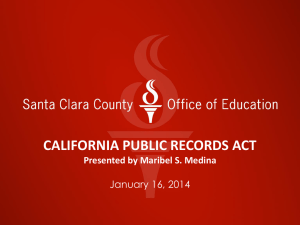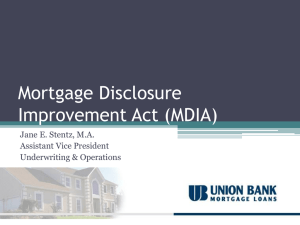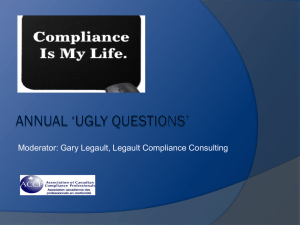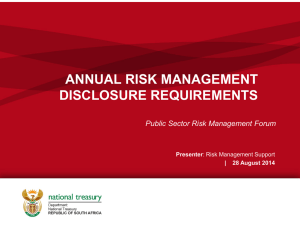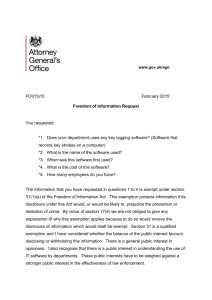Faculty and Staff Outside Activities - National Association of College
advertisement
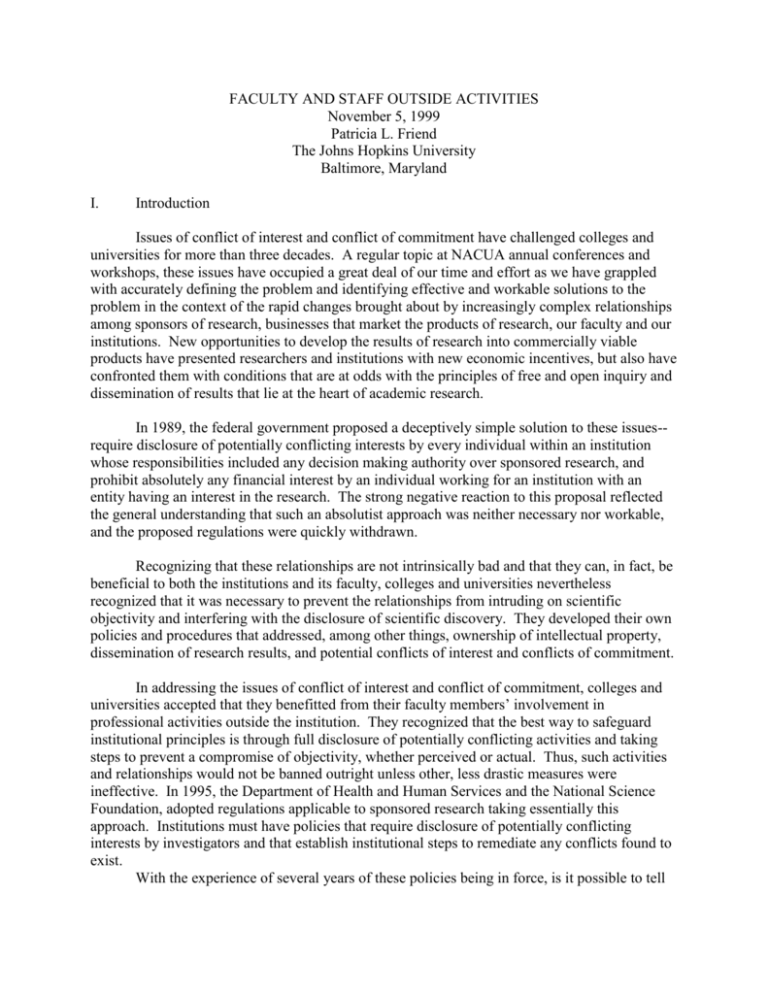
FACULTY AND STAFF OUTSIDE ACTIVITIES November 5, 1999 Patricia L. Friend The Johns Hopkins University Baltimore, Maryland I. Introduction Issues of conflict of interest and conflict of commitment have challenged colleges and universities for more than three decades. A regular topic at NACUA annual conferences and workshops, these issues have occupied a great deal of our time and effort as we have grappled with accurately defining the problem and identifying effective and workable solutions to the problem in the context of the rapid changes brought about by increasingly complex relationships among sponsors of research, businesses that market the products of research, our faculty and our institutions. New opportunities to develop the results of research into commercially viable products have presented researchers and institutions with new economic incentives, but also have confronted them with conditions that are at odds with the principles of free and open inquiry and dissemination of results that lie at the heart of academic research. In 1989, the federal government proposed a deceptively simple solution to these issues-require disclosure of potentially conflicting interests by every individual within an institution whose responsibilities included any decision making authority over sponsored research, and prohibit absolutely any financial interest by an individual working for an institution with an entity having an interest in the research. The strong negative reaction to this proposal reflected the general understanding that such an absolutist approach was neither necessary nor workable, and the proposed regulations were quickly withdrawn. Recognizing that these relationships are not intrinsically bad and that they can, in fact, be beneficial to both the institutions and its faculty, colleges and universities nevertheless recognized that it was necessary to prevent the relationships from intruding on scientific objectivity and interfering with the disclosure of scientific discovery. They developed their own policies and procedures that addressed, among other things, ownership of intellectual property, dissemination of research results, and potential conflicts of interest and conflicts of commitment. In addressing the issues of conflict of interest and conflict of commitment, colleges and universities accepted that they benefitted from their faculty members’ involvement in professional activities outside the institution. They recognized that the best way to safeguard institutional principles is through full disclosure of potentially conflicting activities and taking steps to prevent a compromise of objectivity, whether perceived or actual. Thus, such activities and relationships would not be banned outright unless other, less drastic measures were ineffective. In 1995, the Department of Health and Human Services and the National Science Foundation, adopted regulations applicable to sponsored research taking essentially this approach. Institutions must have policies that require disclosure of potentially conflicting interests by investigators and that establish institutional steps to remediate any conflicts found to exist. With the experience of several years of these policies being in force, is it possible to tell that they have been effective in addressing the issues they were designed to address? Are there issues that are not addressed under these policies that should be addressed? This outline looks at the experience of Johns Hopkins University in the implementation of its School of Medicine’s policy on Conflict of Interest and Conflict of Commitment. The outline then focuses on two areas specific issues of concern to colleges and universities, namely, accounting for faculty members obligations to the institution in balance with outside activities (the day a week rule) and faculty activities adverse to the institution. II. The Johns Hopkins University School of Medicine Policy on Conflict of Commitment and Conflict of Interest A. Overview of the Policy The School of Medicine adopted the precursor of its current Policy on Conflict of Commitment and Conflict of Interest in 1989. A copy of the current policy, updated in 1994, is attached to this outline. The policy states that the primary professional obligation of its full time faculty is to the School of Medicine, but recognizes that the School benefits from outside professional activities of the faculty. Faculty are cautioned to avoid commitments that compromise scholarly independence and are obligated to disclose potential conflicts of interest in writing before accepting a commitment. Reports are made to department directors; if the activity is approved by the department director, the report is submitted to the administrator of the Committee on Conflict of Interest who reviews it for compliance with University and School policy. Certain matters are referred to the Committee on Conflict of Interest. B. Requirement for a written report The policy identifies nine circumstances in which a written report is required. These include: 1. When the aggregate time for all outside activities exceeds 26 days per year; 2. When the outside activity requires a written agreement; 3. As directed by the department director in special circumstances, such as in connection with promotions; 4. When the activity calls for the use of the University’s name and logos; 5. When the activity calls for the use of University facilities and resources; 6. When the activity provides for ownership or licensing of intellectual or tangible property to someone other than the University; 7. When the activity restricts the reporting of the activity or information developed by the faculty member; 8. When the relationship of the faculty member to an outside party might appear to influence the conduct of University business or research; 9. When the activity provides remuneration for clinical practice in addition to the faculty member’s University salary. C. 26 day per year reporting threshold 2 With regard to the reporting threshold of 26 days per year, the policy makes clear that it is not a limit. The maximum amount of time any one faculty member can devote to outside activities is determined with the department director. Intermittent activities, such as lectureships, conferences and scientific and professional meetings are not included unless they fall into another category. Ongoing relationships, consultations, research, teaching, laboratory testing, memberships on boards are reported. D. Numbers of disclosures The Office of the Committee on Conflict of Interest received about 250 disclosures during the last fiscal year. The majority of these (190) involved written agreements for consulting activities and membership on scientific advisory boards. Included within these are a certain number of proposed equity and other financial interests with outside organizations and proposals for those organizations to sponsor ongoing research, which were referred to the Committee for review. The balance (60) comprised nondisclosure agreements and other activities. Disclosures come from several sources, including recognition by the faculty member of the need to disclose; disclosure on forms submitted to the institutional review board and to the Office of Research Administration; agreements negotiated with the Office of Technology Licensing; and disclosures in the annual salary letters that responds to a specific question about outside activities. The School of Medicine does not have an annual disclosure reporting form, as such. The experience with broad reporting requirements, such as those on the annual salary letter, is that the activities reported are for the most part attendance at conferences, presentations and the like--even membership on community association boards. Disclosures that are made through other channels, such as the IRB, research administration, and technology licensing, are generally thought to capture most of the relationships that require review. E. Staff review When a disclosure reaches the Office of the Committee on Conflict of interest, the administrator sends a formal disclosure reporting form to the faculty member involved. Most disclosures involve only review by the administrator of the Committee on Conflict of Interest, as the activities do not trigger review by the Committee. The administrator reviews the proposed agreements for compliance with University and School policies and returns them to the faculty member with required changes noted, if any. The review for compliance includes the intellectual property policy, a determination of the appropriateness of the activity, the use of the University name, among others. If the review discloses a significant time commitment or large compensation to the faculty member, the administrator directs the attention of the department director to those points. The department director has the authority approve the arrangement or suggest modifications to the faculty member. F. Committee review The policy requires review by the Committee on Conflict of Interest in the case of 3 proposals for sponsored research when the faculty member will receive a royalty on the sale of products based on the research or an equity interest in the organization sponsoring the research or to which the research is licensed. The Committee also considers proposals for a faculty member to have a management or directorship in an outside organization, proposals for research by a faculty member whose supervisor has an equity interest in the sponsor, and proposals for research sponsored by an entity that offers a royalty or equity interest to nonfaculty employees or students. The Committee, which meets one time per month, considers from four to 15 disclosures per month. Most cases are considered and decided at the same meeting, although some more complex cases, particularly those involving equity and royalty interests, may require additional consideration. The Committee is advisory to the Dean of the Medical Faculty. The Committee can recommend that an activity be turned down or conditioned. Outright rejections are rare, occurring one or two times per year. Every case results in a recommendation of disclosure of the interest in presentations, publications and consent forms, and the administrator provides standard disclosure language for the faculty member to use. Frequently, the Committee retains responsibility to review the timing of the exercise of stock options or sale of stock, often requiring that these be delayed until after the research is completed and reported. The Committee occasionally requires shares of stock to be placed in escrow until after research is completed and reported. In cases in which research is ongoing, the Committee reviews the timing of any announcements related to the research and attempts to set an appropriate trading window that is independent of research activities. In some cases the Committee has directed a change in the faculty member’s role with respect to the research, requiring the inclusion of a co-principal investigator or oversight of the research by an individual or committee. G. Trends The caseload of the Committee on Conflict of Interest, not surprisingly, has increased since the Committee’s inception in 1992. There are ongoing efforts to make faculty members aware of the policy and the need to disclose outside relationships. There is an increasing number of relationships requiring disclosure and review by the Committee. In addition, the Committee is seeing and expects to see in the future requests to exercise transactions with stock that previously were limited by the Committee while research was ongoing. III. Day per week rule A. Overview Many institutions, recognizing that they benefit when their faculty m embers are involved in professional activities outside those they perform for their institutions, permit their faculty to devote a portion of their time to outside activities so long as the amount of time they spend on those activities does not interfere with their principal professional obligations. Many colleges and universities have quantified this time they permit faculty to spend on outside activities to roughly one day per week. Faculty, however, do not ordinarily 4 pick a day, say Wednesday, and say, “This is my day a week, and I have no responsibilities to the University this day.” Thus, it is commonly understood that “one day per week” is a standard equating to roughly 20% of professional effort. Questions arise as to how that 20% is applied and what activities are included within it. There are no comprehensive studies faculty outside activities and the amount of time faculty spend on those activities in contrast to the amount of time they spend on their university responsibilities. Rather, most of our institutions have relied on the fact that many faculty members do not take advantage of the day per week allowed them, and that those who do use it appear to be quite good judges of the balance between their principal professional obligations and their outside activities. Generally, their consultancy activities, along with their presentations and attendance at scientific and professional meetings, take place in blocks of time that are easily quantifiable and/or can coordinate with the time needed to meet obligations to the university. Occasionally, faculty members have taken the day per week literally and have attempted to carve out a strict divide between the two, usually with reference to the standard 40 hour work week. There are legal implications that need to be considered when this happens. B. Fair Labor Standards Act issues Faculty members generally are treated as professionals exempt from the minimum wage and overtime requirements of the Fair Labor Standards Act, 29 U.S.C. § 213 (a). This means that they are paid a salary to perform their responsibilities, namely to teach their courses, conduct their research, care for patients and perform various service activities for their college or university regardless of the number of hours worked. Exempt employees are responsible for the results of their work, primarily, and secondarily, for their time. Generally, discussion of the time worked by exempt employees, particularly in terms of numbers of hours worked, invites scrutiny of the exempt employees’ responsibilities and whether they are exempt. In light of the strict interpretation that is given to exemptions from FLSA, any effort to quantify the time spent by faculty members on their university responsibilities must be undertaken with a clear understanding that the inquiry will not affect the actual compensation paid to the faculty members. When a faculty member attempts to establish for him or herself a forty hour work week, and then to segregate his or her eight hours for the day per week, this focus on precise numbers of hours worked is, inconsistent with his or her status as an exempt employee, not to mention inconsistent with the faculty members actual responsibilities. C. Time reporting for sponsored research Faculty members whose compensation is paid under federal research grants are responsible for accounting for their time on those grants relative to their time on other activities. One of the methods for tracking time under OMB Circular A-21 is the personnel activity report. Faculty members whose full time salaries are supported from their federal research grants must certify the percentage of time they spend on those projects, as well as time spent on administrative responsibilities and on instruction and departmental research. Grant budgets may not be charged for faculty members’ outside activities, nor are such activities properly included as departmental administration expenses, which are included in the indirect cost pool. For those 5 faculty members who do have significant outside activities, it is important that the university carefully evaluate their activity reports for compliance with government accounting requirements. D. Hidden issues Often the effort by the faculty member to establish a strict forty hour work week and to account for his or her time in this manner is an indication that the faculty member’s principal professional activities are not those performed for the university, but rather the outside activities. Thus, the faculty member is giving only 32 hours to the institution, albeit during the workweek, but has outside activities far in excess of eight hours, and probably the 32 hours he or she is devoting to university responsibilities. When questioned about these activities, moreover, the faculty member is likely to demur, claiming the university has no right to inquire into what he or she is doing during off hours. Thus, it is important to have a policy that requires reporting of outside activities that can be used to enforce disclosure. E. What is included Some policies include all activities that fall outside the direct responsibilities of teaching, research, clinical care and service required of faculty members. Thus, included within the day per week would be presentations and attendance at scientific and professional meetings and participation on the board of editors of journals, which are generally unpaid, as well as consulting and board memberships of outside organizations that are paid. Other policies set a lower reporting threshold, such as the Johns Hopkins School of Medicine policy, but exclude presentations and attendance at meetings of professional and scientific organizations. IV. Activities of faculty members that are adverse to the institution Some activities of faculty members place them at odds with the interests of their employer institutions. The classic example is the faculty member who serves as an expert witness on behalf of a party in litigation with the employer. What are the limits institutions can set on these kinds of activities and what steps can institutions take to limit the damage? A. Issue of freedom of expression To foster the freest and most open inquiry within their walls, colleges and universities have accorded their faculties broad freedom to speak and write on all topics without interference from the institution. While faculties in both public and private institutions enjoy academic freedom, in public institutions, these rights have the additional protection of the First Amendment. Cases decided on First Amendment grounds are illustrative of the breadth of the free speech rights of faculty and illustrate vividly the point that activities that to a lawyer would clearly be a conflict of interest, are matters of freedom of expression to a member of the faculty. B. The case law Beginning with the case of Pickering v. Board of Education, 391 U.S. 563 (1968), the 6 Supreme Court has narrowly limited public employers’ authority to control the speech of their employees. The Court has required a balance of the public employee’s right to speak out on matters of public concern with the interest of the public employer in promoting the efficient delivery of the services it provides through its employees. In Pickering, the Court concluded that a public high school teacher who was critical of a school board’s explanation of the expenditure of building funds was neither in a position to the board requiring loyalty to the board or in a position that would make it difficult to counter the harmful effects of his words because of special access to the facts. Subsequently, in Branti v. Frankel, 445 U.S. 507 (1980), the Supreme Court disapproved of a decision by a new, Democratic public defender to remove two assistant public defender from their positions solely because they belonged to the Republican party. The Court found that the confidential relationship the public defender said he needed with his assistants was really a confidential relationship between the assistants and the clients of the office. Since both assistants were performing their responsibilities satisfactorily, they could not be removed solely because of their political beliefs. In Connick v. Meyers, 461 U.S. 138 (1983), the Court found the balance in favor of the public employer. In that case, an assistant district attorney objected to a proposed transfer and sent a questionnaire to a number of her colleagues that asked questions about the fairness of the supervisors and morale in the office. The questionnaire also asked about whether the assistants felt compelled to make contributions to political campaigns supported by the supervisors. The Court recognized that public offices could not function if every employment decision became a constitutional matter and that if the questionnaire was not speech on a matter of public concern, then there was no need to consider the matter further. While the Court believed that the questions about compelled contributions did touch on matters of public concern, overall the questionnaire was designed to support the individual employee’s grievance with her supervisors and did not constitute protected speech. Subsequently, in Waters v. Churchill, 511 U.S. 661 (1994), the Court recognized the principle implicit in Connick, that as an employer, the state has a stronger interest in promoting the efficient and effective achievement of its goals than when it is acting as a sovereign. The Court held that a state employer could take action with respect to an employee who had spoken critically about her employer to an individual who was being recruited if the employer conducted a reasonable inquiry into the facts. The Court found that the speech in that case was not on a matter of public concern and therefore not protected, or even if it was on a matter of public concern, it was nonetheless disruptive and not protected. In most cases in which college and university faculty members will be retained as experts against their employers, the opinions they offer will touch on matters of public concern. This was precisely the issue presented in Hoover v. Morales, 164 F.3d 221 (5th Cir. 1998). This case presented a challenge to two policies of Texas A & M University that were consistent with state law. The first policy prohibited state employees from acting as consultants or expert witnesses on behalf of parties in litigation against the state. The second prohibited payment of the salary of a state employee who acts as a consultant or expert witness on behalf of a party in litigation against the state. The case against Texas A & M was brought on behalf of several faculty members who were expert witnesses against the state in its lawsuit against the tobacco industry 7 and another faculty member who was appearing on behalf of a community association opposed to the location of an incinerator. The court first concluded that this was not commercial speech even if the individuals were being compensated, analogizing the speech to the speech of writers who get paid for their books. The court had little difficulty in concluding that the speech of the faculty members addressed matters of public concern. In the balance between the faculty members interest in speaking out on matters of public concern and the state’s interest in promoting the effective and efficient delivery of services through its employees, the court easily concluded that the faculty members’ interest outweighed the state’s “amorphous interest in protecting its interests.” There was little if any evidence that the expert testimony would in anyway impact the delivery of educational services by the faculty members. Finally, the court was troubled by the content discrimination inherent in the policies--the only speech prohibited was that against the state, but faculty members were free to be consultants or expert witnesses on behalf of the state. C. Conclusions If a college or university permits a faculty member to engage in outside activities such as consulting or appearing as an expert witness, any effort by the college or university to prohibit that faculty member from engaging in those activities in a manner that is adverse to the college or university is going to invite a challenge on academic freedom and, if a public institution, First Amendment grounds. It is possible to conceive of a hypothetical case in which the college or university might legitimately object--a sociology professor who is an expert on employment discrimination appearing on behalf of an former employee of the department in a discrimination case where the faculty member participated in the decision to terminate the employee. The attempt to limit the faculty member from appearing, however, may have other consequences to the litigation that need to be considered. 8
